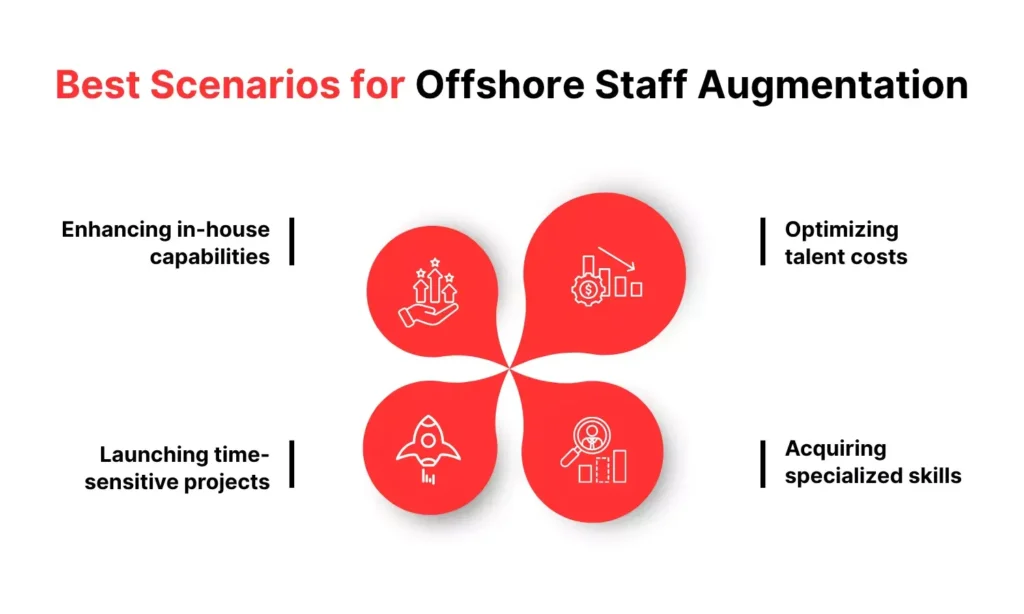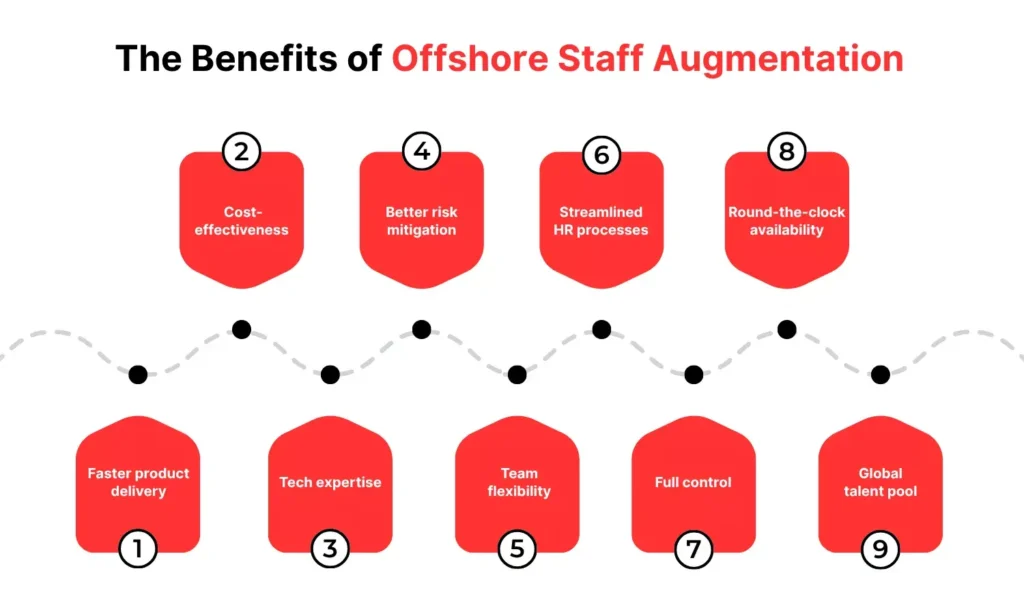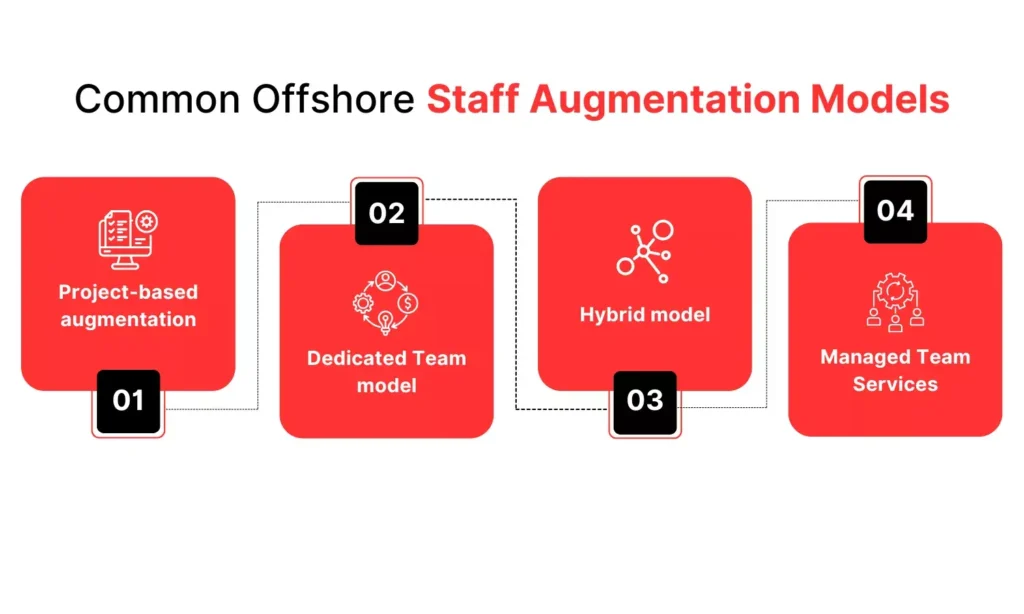Offshore staff augmentation has emerged as a transformative solution for businesses seeking to address talent shortages and optimize operational costs in today’s competitive landscape.
This strategic approach enables organizations to access global talent pools while maintaining complete control over their project development and team dynamics.
The staff augmentation model provides unprecedented flexibility, allowing companies to scale their workforce rapidly without the traditional constraints of geographical boundaries.
The offshore staff augmentation market continues to experience remarkable growth, with projections indicating the industry will reach nearly $82 billion by 2025.
Businesses are increasingly recognizing the value proposition of this model, as evidenced by the substantial cost savings and enhanced operational efficiency it delivers.
Organizations across various industries are adopting staff augmentation strategies to remain competitive and achieve their strategic objectives in an increasingly digital-first economy.
What Is Offshore Staff Augmentation?
Understanding the fundamental principles of offshore staff augmentation is essential for businesses considering this strategic approach to talent acquisition and team expansion.
Furthermore, offshore augmentation provides a comprehensive solution that addresses both immediate staffing needs and long-term organizational growth objectives.
Definition and Core Concepts
Staff augmentation outsourcing is the process of hiring professionals with the necessary expertise from other countries, generally located on different continents.
Moreover, this approach allows organizations to supplement their existing teams with skilled professionals who work as integrated members of the company’s workforce.
Offshore augmentation maintains direct management control while leveraging global talent pools to enhance project capabilities and accelerate business growth.
Offshore vs. Nearshore vs. Onshore Models
Onshore teams offer alignment in time zones and communication. Offshore teams reduce costs and provide access to niche skills. Furthermore, nearshore models provide a middle ground, offering moderate cost savings with better time zone compatibility than offshore alternatives.
Each model presents distinct advantages, with offshore staff augmentation typically delivering the highest cost optimization potential while requiring more sophisticated communication and project management strategies.
How It Differs from Traditional Outsourcing
Offshore staff augmentation differs fundamentally from traditional outsourcing by maintaining direct control over team members and project execution.
Augmented staff work as dedicated team members rather than external contractors, ensuring better alignment with company culture and objectives.
This model provides greater flexibility in resource allocation and project management compared to conventional outsourcing arrangements.
Why Businesses Choose Offshore Staff Augmentation

The strategic decision to implement offshore staff augmentation stems from multiple compelling business drivers that directly impact organizational performance and competitive positioning.
Moreover, these factors create a strong business case for adopting this model across various industries and company sizes. Understanding these motivations helps organizations evaluate whether offshore staff augmentation aligns with their specific business objectives and operational requirements.
Access to Global Talent Pool
Offshore staff augmentation provides unprecedented access to diverse skill sets and expertise that may be scarce or expensive in local markets.
Furthermore, this global reach enables organizations to tap into specialized knowledge and experience from different regions and cultures. Additionally, the expanded talent pool allows companies to find professionals with precisely the right skills and experience levels for their specific project requirements.
Significant Cost Savings (40-70% reduction)
Companies using offshore staff augmentation save an average of 40-60% on development costs.
Moreover, these savings extend beyond salary costs to include reduced infrastructure, benefits, and overhead expenses. Additionally, the cost optimization potential enables organizations to reallocate resources toward strategic initiatives and business growth opportunities.
Rapid Scaling and Flexibility
Offshore staff augmentation enables organizations to scale teams rapidly in response to changing project requirements and market demands. This flexibility allows companies to adjust workforce capacity without the long-term commitments associated with traditional hiring.
Additionally, the ability to quickly onboard specialized professionals ensures projects maintain momentum and meet critical deadlines effectively.
24/7 Development Capabilities
Global team distribution through offshore staff augmentation creates opportunities for continuous development cycles and accelerated project timelines. Moreover, strategic time zone leveraging enables round-the-clock productivity and faster problem resolution.
Additionally, this approach provides significant advantages for urgent projects and competitive market situations requiring rapid deployment.
Key Benefits of Offshore Staff Augmentation

The comprehensive benefits of offshore staff augmentation extend far beyond cost savings, encompassing strategic advantages that fundamentally enhance organizational capabilities and competitive positioning.
Moreover, these benefits create compound value over time, contributing to sustained business growth and operational excellence.
Cost Optimization and Budget Management
Offshore staff augmentation delivers exceptional cost optimization through reduced labor expenses, eliminated infrastructure costs, and optimized resource allocation.
This model provides predictable budgeting with transparent pricing structures and flexible engagement options. Additionally, organizations can redirect cost savings toward innovation initiatives, market expansion, and strategic business development activities.
Access to Specialized Skills and Expertise
Global talent pools provide access to highly specialized skills and cutting-edge expertise that may be difficult to find locally. Additionally, this specialized knowledge accelerates project delivery and enhances solution quality through proven methodologies and innovative approaches.
Faster Time-to-Market for Projects
Offshore staff augmentation significantly reduces project timelines through immediate access to skilled professionals and proven development processes.
Furthermore, experienced offshore teams contribute established methodologies and efficient workflows that accelerate project completion. The ability to quickly scale teams ensures projects maintain optimal resource levels throughout their lifecycle.
Reduced Administrative Overhead
The offshore staff augmentation model eliminates many administrative burdens associated with traditional hiring, including recruitment, benefits management, and HR compliance.
Moreover, established offshore partners handle legal requirements, payroll processing, and administrative tasks efficiently. Additionally, this reduction in administrative overhead allows internal teams to focus on core business activities and strategic initiatives.
Cultural Diversity and Innovation
Diverse offshore teams bring fresh perspectives, innovative approaches, and creative problem-solving capabilities that enhance project outcomes. Furthermore, cultural diversity fosters innovation through different thinking patterns and varied experience backgrounds.
International collaboration enriches organizational culture and develops global business competencies within the company.
Common Offshore Staff Augmentation Models

Understanding the various offshore staff augmentation models enables organizations to select the most appropriate approach for their specific requirements and operational preferences.
Moreover, each model offers distinct advantages and considerations that align with different project types and business objectives. Additionally, selecting the optimal model ensures maximum value realization and successful project outcomes from offshore staff augmentation initiatives.
Project-Based Augmentation Model
Project-based offshore staff augmentation focuses on specific deliverables with defined timelines and established success criteria. Furthermore, this model provides cost predictability and resource optimization for discrete projects with well-defined requirements.
Project-based arrangements offer flexibility to engage different specialists for various project phases while maintaining budget control.
Dedicated Team Model
The dedicated team model creates long-term partnerships with offshore professionals who become integral members of the organization’s workforce. Dedicated teams develop a deep understanding of business processes, company culture, and strategic objectives over time.
Additionally, this model provides stability, consistency, and enhanced productivity through sustained collaboration and knowledge accumulation.
Hybrid Engagement Models
Hybrid offshore staff augmentation models combine multiple approaches to optimize resource allocation and project management effectiveness.
Furthermore, these flexible arrangements adapt to changing project requirements and business priorities throughout the engagement lifecycle. Hybrid models provide the benefits of both dedicated resources and project-specific expertise as needed.
Managed Team Services
Managed team services provide comprehensive project management and team coordination through experienced offshore partners who handle day-to-day operations.
This model reduces management overhead while ensuring professional project execution and quality assurance. Additionally, managed services include performance monitoring, quality control, and continuous improvement processes that enhance project outcomes.
Cost Analysis and Savings Potential
Comprehensive cost analysis reveals the substantial financial benefits of offshore staff augmentation while highlighting important considerations for accurate budget planning and ROI optimization.
Furthermore, understanding the complete cost structure enables organizations to make informed decisions and maximize their investment returns.
Regional Cost Comparisons (US vs. Eastern Europe vs. Asia)
Regional cost variations significantly impact offshore staff augmentation economics, with Eastern European developers typically costing 50-70% less than US equivalents, while Asian markets offer even greater savings.
Furthermore, quality levels remain consistently high across these regions, ensuring excellent value propositions. Additionally, regional specializations and market maturity levels create opportunities for optimal cost-quality balance based on specific project requirements.
Hidden Costs and Total Cost of Ownership
While offshore staff augmentation delivers substantial savings, organizations must consider hidden costs, including communication overhead, project management expenses, and quality assurance requirements.
Moreover, a comprehensive total cost of ownership analysis includes onboarding, training, and integration expenses.
ROI Calculation Framework
Effective ROI calculation for offshore staff augmentation includes direct cost savings, productivity improvements, time-to-market acceleration, and strategic value creation. Additionally, tracking ROI metrics over time provides insights for continuous optimization and strategic decision-making.
Budget Planning and Cost Optimization Strategies
Strategic budget planning for offshore staff augmentation includes phased implementation approaches, flexible resource allocation, and continuous cost monitoring processes. Moreover, optimization strategies focus on maximizing value while maintaining quality standards and project objectives.
Popular Offshore Destinations in 2026
The global landscape of offshore staff augmentation destinations continues to evolve, with established regions maintaining their leadership while emerging markets present new opportunities for cost optimization and specialized expertise.
Eastern Europe (Poland, Ukraine, Romania)
Eastern European countries offer exceptional offshore staff augmentation opportunities through highly educated workforce, strong technical capabilities, and favorable time zone alignment with Western markets.
Furthermore, the region provides excellent English proficiency and cultural compatibility that facilitates smooth collaboration. Additionally, established IT infrastructure and government support create stable environments for long-term offshore partnerships.
Asia-Pacific (India, Philippines, Vietnam)
The Asia-Pacific region continues to dominate offshore staff augmentation markets through competitive pricing, large talent pools, and mature service delivery capabilities.
Moreover, countries like India provide extensive experience in global project delivery and comprehensive skill sets across multiple technologies.
Latin America (Mexico, Brazil, Argentina)
Latin American destinations provide attractive nearshore alternatives with favorable time zones, cultural affinity, and competitive costs for North American companies.
The region offers strong technical education systems and growing English proficiency levels. Additionally, government initiatives supporting technology sectors create stable environments for offshore staff augmentation partnerships.
Emerging Markets and New Opportunities
Emerging offshore destinations, including certain African and Middle Eastern countries, present new opportunities for cost optimization and access to untapped talent pools.
Moreover, these markets often provide highly motivated professionals with competitive pricing and growing technical capabilities. Early adoption of emerging markets can provide competitive advantages through exclusive partnerships and preferential pricing structures.
Challenges and How to Overcome Them
Successfully implementing offshore staff augmentation requires proactive identification and mitigation of potential challenges that could impact project success and team effectiveness.
Moreover, understanding these challenges enables organizations to develop comprehensive strategies that ensure smooth operations and optimal outcomes..
Communication and Language Barriers
Effective communication strategies for offshore staff augmentation include establishing clear protocols, utilizing collaborative tools, and ensuring adequate language proficiency levels.
Furthermore, regular communication schedules and structured reporting processes minimize misunderstandings and maintain project alignment.
Time Zone Management Strategies
Strategic time zone management involves establishing overlapping work hours, implementing asynchronous communication protocols, and utilizing project management tools that support distributed teams.
Additionally, rotating meeting times and flexible scheduling accommodate different time zones fairly and maintain team engagement.
Cultural Differences and Team Integration
Successful cultural integration requires understanding different work styles, communication preferences, and business practices while creating inclusive team environments. Furthermore, cultural awareness training and team-building activities foster mutual understanding and collaboration.
Establishing shared values and common objectives helps bridge cultural differences and create cohesive team dynamics.
Quality Control and Project Management
Robust quality control processes for offshore staff augmentation include clear standards, regular reviews, and comprehensive testing procedures that ensure deliverable quality. Moreover, experienced project managers provide oversight and coordination that maintains project momentum and quality standards.
Security and Data Protection Concerns
Comprehensive security measures for offshore staff augmentation include secure communication channels, data encryption, access controls, and compliance with international security standards.
Furthermore, established offshore partners maintain certifications and implement robust security protocols that protect sensitive information.
Best Practices for Successful Offshore Staff Augmentation
Implementing proven best practices ensures optimal outcomes from offshore staff augmentation initiatives while minimizing risks and maximizing value realization.
Moreover, these practices are based on extensive industry experience and successful project implementations across various sectors.
Partner Selection Criteria and Due Diligence
Thorough partner evaluation for offshore staff augmentation includes assessing technical capabilities, project experience, security standards, and cultural fit with organizational requirements.
Furthermore, comprehensive due diligence examines financial stability, legal compliance, and client references to ensure reliable partnerships.
Performance Management and Quality Assurance
Comprehensive performance management systems for offshore staff augmentation include clear metrics, regular evaluations, and continuous feedback mechanisms that ensure optimal team performance.
Additionally, performance improvement plans and recognition programs motivate excellence and support professional development.
Legal and Compliance Considerations
Legal compliance for offshore staff augmentation requires understanding international employment laws, intellectual property protection, and regulatory requirements across different jurisdictions.
Furthermore, comprehensive contracts address data protection, confidentiality, and liability considerations that protect organizational interests.
Technology Skills in High Demand
The technology landscape continues to evolve rapidly, creating high demand for specialized skills that are often scarce in local markets but readily available through offshore staff augmentation partnerships.
Moreover, these in-demand skills command premium rates globally, making offshore access particularly valuable for cost-conscious organizations. Additionally, staying current with technology trends ensures optimal resource planning and skill acquisition strategies.
AI and Machine Learning Specialists
Artificial intelligence and machine learning specialists represent the fastest-growing category in offshore staff augmentation, with demand increasing exponentially across all industries.
Furthermore, these professionals bring specialized knowledge in algorithms, data science, and implementation frameworks that are critical for digital transformation initiatives.
Cloud Computing and DevOps Engineers
Cloud computing and DevOps expertise remain in high demand as organizations accelerate their digital transformation and modernization initiatives through comprehensive infrastructure upgrades.
Additionally, DevOps practitioners provide critical skills for continuous integration, deployment, and infrastructure management.
Mobile and Web Development Professionals
Mobile and web development continue to represent core requirements for offshore staff augmentation as organizations expand their digital presence and customer engagement capabilities. Moreover, experienced developers bring knowledge of modern frameworks, responsive design, and user experience optimization.
Emerging Technology Specialists (Blockchain, IoT)
Blockchain, IoT, and other emerging technologies create new opportunities for offshore staff augmentation as organizations explore innovative applications and competitive advantages. Furthermore, early adopters of these technologies often have extensive experimental experience and implementation knowledge. Additionally, emerging technology specialists bring forward-thinking perspectives and innovative approaches to traditional business challenges.
Choosing the Right Offshore Staff Augmentation Partner
Selecting the optimal offshore staff augmentation partner represents a critical decision that significantly impacts project success, cost effectiveness, and long-term business outcomes.
The partner selection process requires a comprehensive evaluation of multiple factors, including technical capabilities, cultural fit, and strategic alignment.
Evaluation Criteria and Assessment Framework
Comprehensive evaluation frameworks for offshore staff augmentation partners include technical assessment, project management capabilities, communication skills, and cultural compatibility measures. Furthermore, standardized evaluation criteria enable objective comparison and informed decision-making across multiple potential partners. Additionally, weighted scoring systems help prioritize factors based on specific project requirements and organizational preferences.
Technical Expertise and Industry Experience
Technical expertise evaluation focuses on core competencies, technology specializations, certification levels, and relevant project experience that align with specific requirements.
Moreover, industry experience provides valuable context and understanding of sector-specific challenges and best practices. Additionally, technical assessments through coding challenges and portfolio reviews validate claimed capabilities and expertise levels.
Communication and Project Management Capabilities
Strong communication and project management capabilities ensure smooth collaboration and successful project delivery through established processes and experienced leadership.
Additionally, communication skills assessment includes language proficiency, cultural awareness, and collaborative work style compatibility.
Scalability and Long-term Partnership Potential
Scalability assessment evaluates the partner’s ability to grow with changing requirements and support long-term business objectives through flexible resource allocation.
Furthermore, partnership potential includes cultural alignment, strategic vision compatibility, and commitment to mutual success.
Implementation Strategy and Timeline
Developing a comprehensive implementation strategy for offshore staff augmentation ensures systematic deployment, risk mitigation, and optimal value realization throughout the engagement lifecycle.
Project Planning and Requirement Definition
Thorough project planning for offshore staff augmentation begins with detailed requirement definition, scope clarification, and success criteria establishment that guide partner selection and implementation.
Additionally, stakeholder alignment and communication planning ensure consistent understanding and support throughout the implementation process.
Partner Selection and Contract Negotiation
Strategic partner selection involves detailed evaluation, reference checking, and pilot project assessment, followed by comprehensive contract negotiation that protects interests while enabling collaboration.
Moreover, contract terms should address intellectual property, data protection, performance standards, and termination procedures.
Team Setup and Integration Process
Effective team setup for offshore staff augmentation includes resource allocation, role definition, onboarding execution, and integration activities that ensure smooth transition and productivity.
Additionally, mentorship programs and knowledge transfer activities accelerate team effectiveness and project contribution.
Performance Monitoring and Optimization
Continuous performance monitoring includes metric tracking, regular assessments, and optimization activities that ensure optimal outcomes and continuous improvement throughout the engagement. Moreover, monitoring systems provide visibility into productivity, quality, and collaboration effectiveness.
Scaling and Long-term Management
Scaling strategies for offshore staff augmentation include capacity planning, skill diversification, and relationship management that support business growth and evolving requirements.
Additionally, scaling considerations include market expansion, technology evolution, and organizational change management.
Future Trends in Offshore Staff Augmentation
The offshore staff augmentation industry continues to evolve rapidly, driven by technological advancements, changing work patterns, and shifting business requirements that create new opportunities and challenges.
Moreover, understanding emerging trends enables organizations to prepare for future developments and maintain competitive advantages.
AI-Powered Talent Matching and Management
Artificial intelligence technologies are revolutionizing offshore staff augmentation through automated talent matching, skill assessment, and project allocation that enhance efficiency and accuracy. Furthermore, AI-powered platforms provide data-driven insights and predictive analytics that improve decision-making and resource optimization.
Remote-First Work Culture Evolution
The evolution toward remote-first work cultures accelerates offshore staff augmentation adoption by normalizing distributed teams and virtual collaboration across all business functions. Additionally, remote-first approaches eliminate geographical constraints and expand talent pool access significantly.
Specialized Niche Skills Demand
Increasing demand for specialized niche skills drives offshore staff augmentation growth as organizations seek expertise in emerging technologies and specific industry applications.
Furthermore, skill specialization creates opportunities for premium pricing and competitive differentiation. Additionally, niche expertise often requires global talent sourcing due to limited local availability.
Regulatory Changes and Compliance Requirements
Evolving regulatory frameworks and compliance requirements impact offshore staff augmentation through new legal considerations, data protection standards, and cross-border employment regulations.
Compliance requirements create opportunities for specialized providers who maintain current certifications and expertise.
Conclusion
Offshore staff augmentation represents a strategic imperative for modern businesses seeking to optimize costs, access global talent, and maintain competitive advantages in an increasingly digital economy.
The comprehensive benefits of this approach extend far beyond cost savings to include enhanced capabilities, accelerated innovation, and strategic flexibility that drive sustainable growth.
Successful offshore staff augmentation implementation requires careful planning, partner selection, and ongoing management to realize maximum value potential.
We at American Chase help businesses achieve optimal resource utilization while maintaining the agility required for sustained market leadership.
We understand the evolution of remote work culture, and we know that advancing technologies create unprecedented opportunities for seamless international collaboration.
FAQs
What is the difference between offshore staff augmentation and traditional outsourcing?
Offshore staff augmentation provides direct control over team members who work as dedicated employees, while traditional outsourcing involves contracting entire projects to external companies with limited oversight and integration.
How do I know if offshore staff augmentation is right for my business?
Offshore staff augmentation is ideal for businesses facing talent shortages, seeking cost optimization, requiring specialized skills, or needing flexible scaling capabilities without long-term hiring commitments.
What are the risks of offshore staff augmentation, and how can they be managed?
Key risks include communication barriers, quality control issues, and security concerns, which can be managed through careful partner selection, clear processes, robust security measures, and regular monitoring.
How quickly can I onboard offshore staff?
Typical onboarding timelines range from 1-4 weeks, depending on role complexity, with experienced offshore partners providing streamlined processes that accelerate integration and productivity.
What are the best countries for offshore staff augmentation in 2026?
Leading destinations include Eastern Europe (Poland, Ukraine, Romania), Asia-Pacific (India, Philippines, Vietnam), and Latin America (Mexico, Brazil, Argentina) based on skill availability and cost effectiveness.
How do I ensure data security and compliance with offshore teams?
Ensure security through partner certifications, secure communication channels, data encryption, access controls, compliance audits, and comprehensive contractual protections.
Can I scale my offshore team up or down as needed?
Yes, offshore staff augmentation provides excellent scalability, allowing rapid team expansion or reduction based on project requirements and business needs with minimal administrative overhead.
What are the typical costs involved in offshore staff augmentation?
Costs vary by region and skill level, with potential savings of 40-70% compared to local hiring, including reduced infrastructure, benefits, and administrative expenses.
How do I manage time zone differences with offshore staff?
Manage time zones through overlapping work hours, asynchronous communication tools, rotating meeting schedules, and clear documentation practices that support distributed team collaboration.







